Tutorial on Anomaly Sound Detection (by Roger Jang)
This tutorial covers the basics of using HMM (Hidden Markov Models) for anomaly sound detection (ASD) for a pounding machine. The anomaly sounds were collected when there is no object to be pounded under the machine. Here are the videos to show the situation when the audio data was collected.
Contents
Preprocessing
Before we start, let's add necessary toolboxes to the search path of MATLAB:
addpath d:/users/jang/matlab/toolbox/utility addpath d:/users/jang/matlab/toolbox/sap addpath d:/users/jang/matlab/toolbox/machineLearning
All the above toolboxes can be downloaded from the author's toolbox page. Make sure you are using the latest toolboxes to work with this script.
For compatibility, here we list the platform and MATLAB version that we used to run this script:
fprintf('Platform: %s\n', computer); fprintf('MATLAB version: %s\n', version); fprintf('Date & time: %s\n', char(datetime)); scriptStartTime=tic; % Timing for the whole script
Platform: PCWIN64 MATLAB version: 9.6.0.1214997 (R2019a) Update 6 Date & time: 20-Jan-2020 00:25:22
Most of the modifiable options for ASD are set in asdOptSet.m:
type asdOptSet
function asdOpt=asdOptSet
% vdOptSet: Set options for ASD (anomaly sound detection)
%
% Usage:
% asdOpt=asdOptSet;
%
% Description:
% asdOpt=asdOptSet returns the default options for ASD.
%
% Example:
% asdOpt=asdOptSet
% Category: Options for anomaly sound detection
% Roger Jang, 20191213
%% === Function for feature extraction and plotting
asdOpt.feaType='mfcc'; % 'MFCC' or 'spectrum';
asdOpt.feaExtractFcn=@asdFeaExtractFromFile;
asdOpt.hmmPlotFcn=@asdHmmPlot;
%% === Folder for wave files
asdOpt.audioDir='D:\users\jang\app\anomalySoundDetect-iii\anomalySoundDetect\dataset';
%% === Parameters for ASD
asdOpt.frameDuration=32; % ms
asdOpt.overlapDuration=16; % Frame step/shift
asdOpt.outputName={'silence', 'normal', 'abnormal'};
asdOpt.gaussianNum=3; % No. of Gaussians for each class
If you want to run this script, you need to change asOpt.audioDir such that it points to a folder of sound files containing audio files with normal or abnormal pounding sounds. The dataset used in the script can be downloaded from this link.
Dataset collection and feature extraction
First of all, we can collect all the sound files once they are downloaded. We can use the commmand "mmDataCollect" to collect all the file information:
asdOpt=asdOptSet; opt=mmDataCollect('defaultOpt'); opt.extName='wav'; auSet=mmDataCollect(asdOpt.audioDir, opt, 1);
Collecting 2 files with extension "wav" from "D:\users\jang\app\anomalySoundDetect-iii\anomalySoundDetect\dataset"...
For each audio file, we assume its pounding sounds have been labeled as cues by using Cooledit. Then we can perform frame-based feature extraction and obtain the groundtruth for each frame. This is achieved by the function "asdFeaExtractFromFile.m", as shown by the following example:
auFile='dataSet/abnormal-cue.wav'; au=myAudioRead(auFile); au.signal=au.signal(:,1); % Use a single channle for feature extraction asdOpt=asdOptSet; asdOpt.feaType='mfcc'; fea=asdFeaExtractFromFile(au, asdOpt, 1);
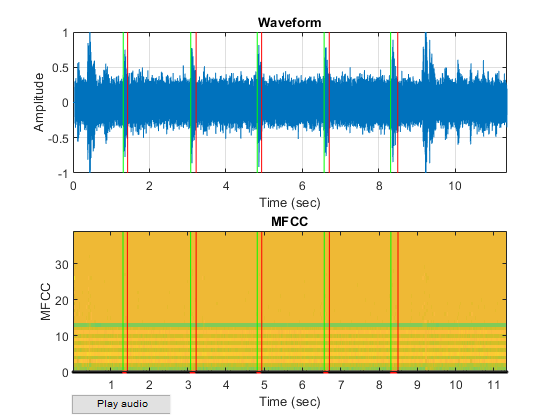
Now we can read audio contents from all audio files. We need to do so since we want to use channel 1 as the training set and channel 2 as the test set.
for i=1:length(auSet) au=myAudioRead(auSet(i).path); % auSet(i)=structCopy(auSet(i), au); auSet(i).signal=au.signal; auSet(i).fs=au.fs; auSet(i).nbits=au.nbits; auSet(i).file=au.file; end
Create the training set from channel 1:
auSetTrain=auSet; for i=1:length(auSetTrain) auSetTrain(i).signal=auSetTrain(i).signal(:,1); end
Create the test set from channel 2:
auSetTest=auSet; for i=1:length(auSetTest) auSetTest(i).signal=auSetTest(i).signal(:,2); end
Now we can perform feature extraction and attach the features to auSet:
myTic=tic; fprintf('Feature extraction from auSetTrain:\n'); auSetTrain=auSetFeaExtract(auSetTrain, asdOpt, 1); fprintf('Feature extraction from auSetTest:\n'); auSetTest=auSetFeaExtract(auSetTest, asdOpt, 1); fprintf('Saving auSetTrain & auSetTest to asdAuSet.mat...\n'); save asdAuSet auSetTrain auSetTest fprintf('time=%g sec\n', toc(myTic));
Feature extraction from auSetTrain: 1/2: file=D:\users\jang\app\anomalySoundDetect-iii\anomalySoundDetect\dataset/abnormal-cue.wav, duration=11.3546 sec, time=0.862437 sec
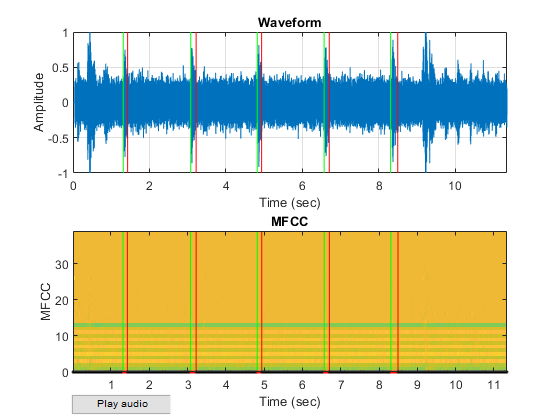
2/2: file=D:\users\jang\app\anomalySoundDetect-iii\anomalySoundDetect\dataset/normal-cue.wav, duration=114.335 sec, time=7.8572 sec
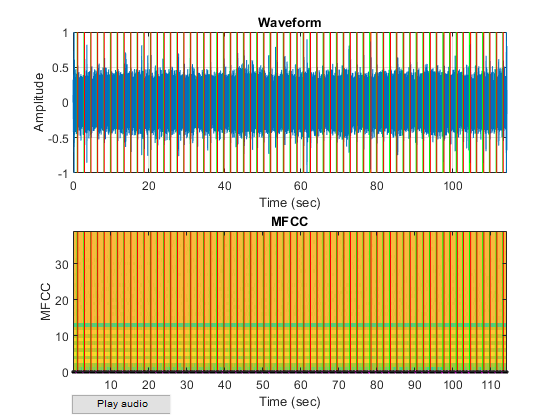
Total time=16.4878 sec Feature extraction from auSetTest: 1/2: file=D:\users\jang\app\anomalySoundDetect-iii\anomalySoundDetect\dataset/abnormal-cue.wav, duration=11.3546 sec, time=0.803897 sec
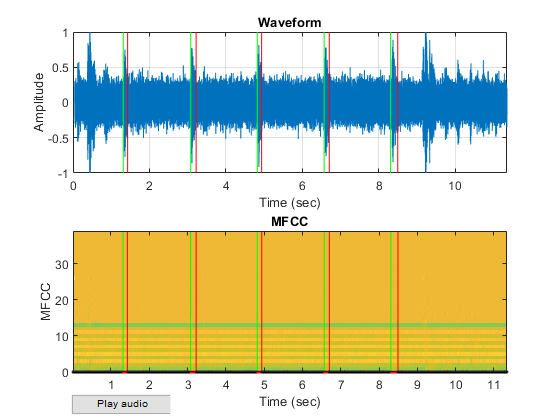
2/2: file=D:\users\jang\app\anomalySoundDetect-iii\anomalySoundDetect\dataset/normal-cue.wav, duration=114.335 sec, time=7.89879 sec
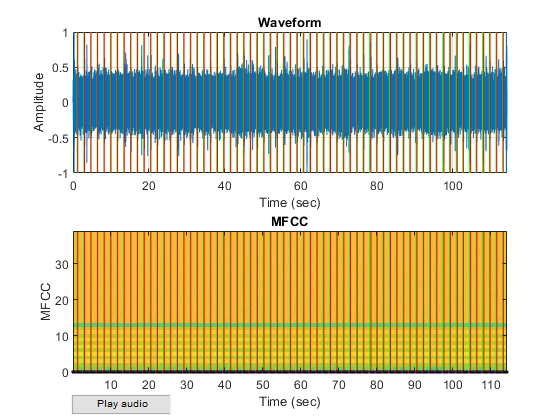
Total time=16.494 sec Saving auSetTrain & auSetTest to asdAuSet.mat... time=36.5891 sec
We can also create a variable DS for all kinds of data visualization and static classification:
feature=[auSetTrain.feature]; output=[auSetTrain.tOutput]; ds.input=feature; ds.output=output; %ds.inputName=asdOpt.featureName; ds.outputName=asdOpt.outputName; ds2=ds; ds2.input=inputNormalize(ds2.input); % input normalization fprintf('ds and ds2 created.\n');
ds and ds2 created.
Data analysis and visualization
We can display data count for each class:
figure; [classSize, classLabel]=dsClassSize(ds, 1);
39 features 7848 instances 3 classes
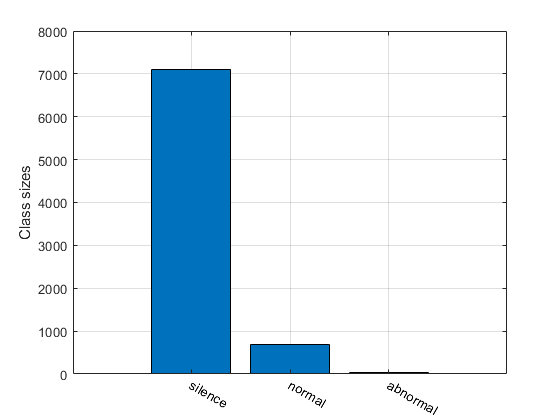
We can plot feature distribution among different classes:
figure; dsBoxPlot(ds);
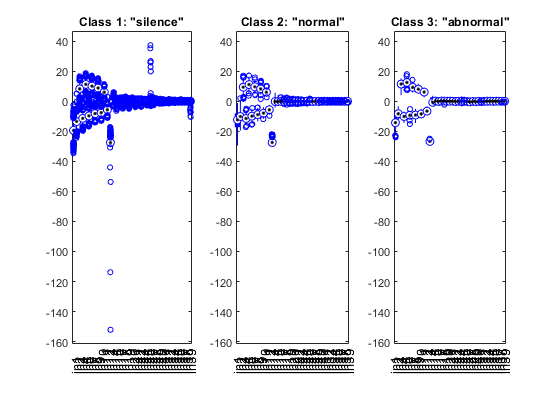
We can also plot all features in each class with the same scale:
figure; dsFeaVecPlot(ds);
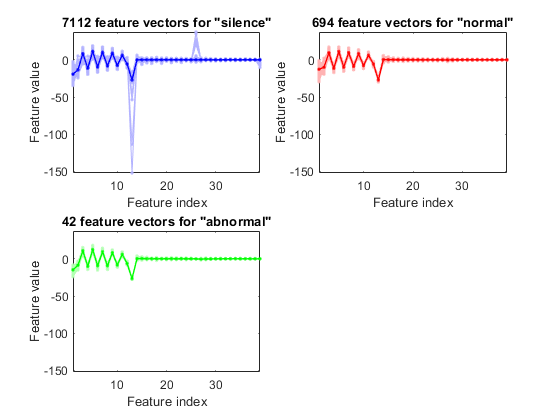
Model training and test using HMM
Using the collected auSet, we can start HMM training for ASD:
fprintf('Start HMM training...\n'); figure; myTic=tic; asdHmmModel=hmmTrain4audio(auSetTrain, asdOpt, 1); fprintf('time=%g sec\n', toc(myTic)); fprintf('Saving asdHmmModel...\n'); save asdHmmModel asdHmmModel % Obtain asdHmmModel
Start HMM training... time=1.58787 sec Saving asdHmmModel...
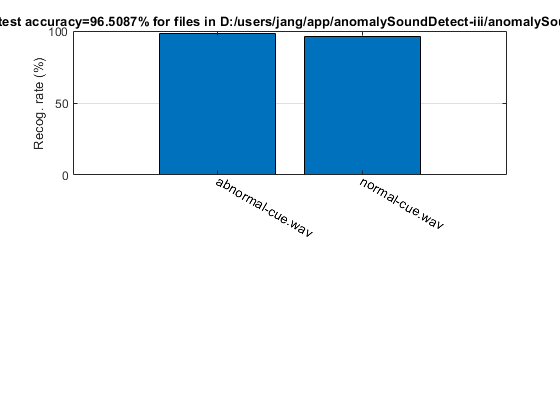
Now we can perform inside test us the training set:
fprintf('HMM inside test using channel 1:\n'); for i=1:length(auSetTrain) fprintf('%d/%d: file=%s\n', i, length(auSetTrain), auSetTrain(i).file); myTic=tic; figure; au=hmmEval4audio(auSetTrain(i), asdOpt, asdHmmModel, 1); fprintf('\tTime=%g sec, accuracy=%g%%\n', toc(myTic), au.rr*100); snapnow; end
HMM inside test using channel 1: 1/2: file=D:\users\jang\app\anomalySoundDetect-iii\anomalySoundDetect\dataset/abnormal-cue.wav
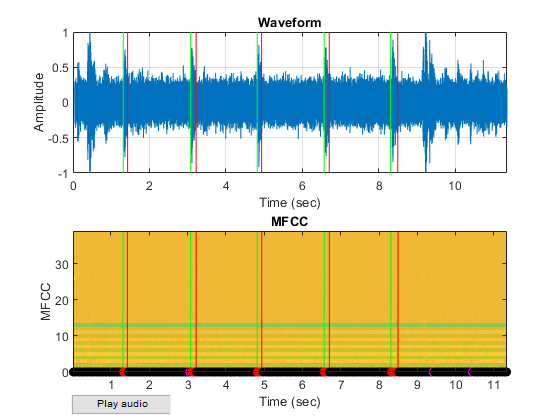
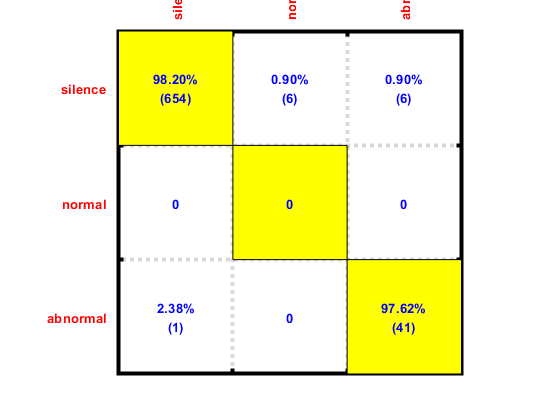
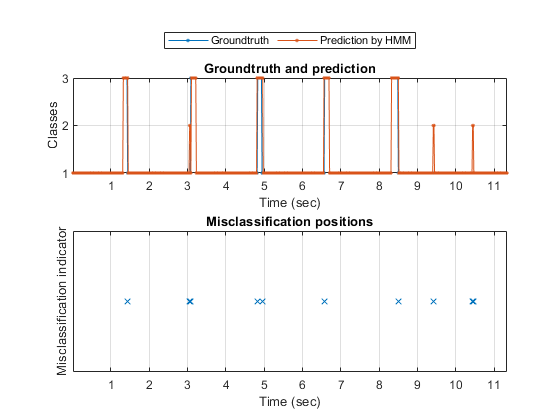
Time=4.52382 sec, accuracy=98.1638%
2/2: file=D:\users\jang\app\anomalySoundDetect-iii\anomalySoundDetect\dataset/normal-cue.wav
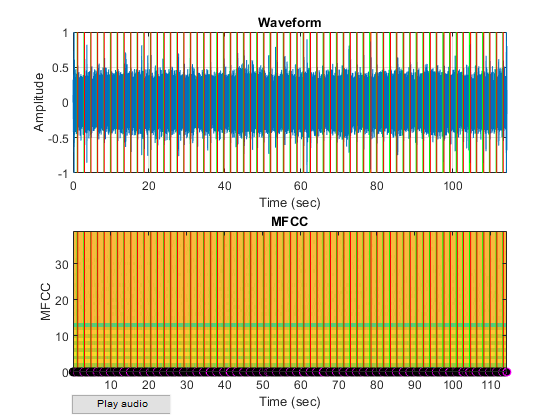
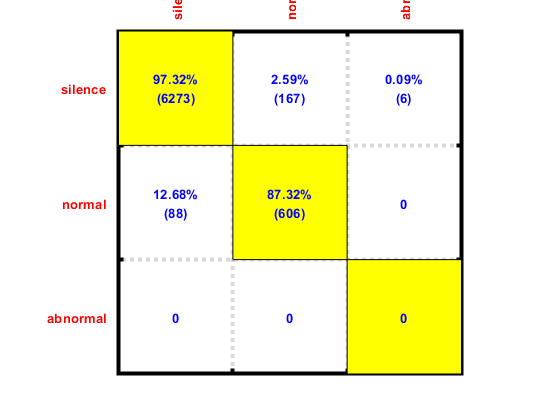
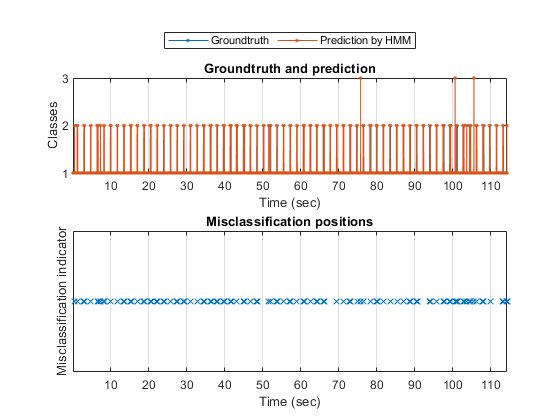
Time=24.4576 sec, accuracy=96.3445%
And the outside test using the test set:
fprintf('HMM outside test using channel 2:\n'); for i=1:length(auSetTest) fprintf('%d/%d: file=%s\n', i, length(auSetTest), auSetTest(i).file); myTic=tic; figure; au=hmmEval4audio(auSetTest(i), asdOpt, asdHmmModel, 1); fprintf('\tTime=%g sec, accuracy=%g%%\n', toc(myTic), au.rr*100); snapnow; end
HMM outside test using channel 2: 1/2: file=D:\users\jang\app\anomalySoundDetect-iii\anomalySoundDetect\dataset/abnormal-cue.wav
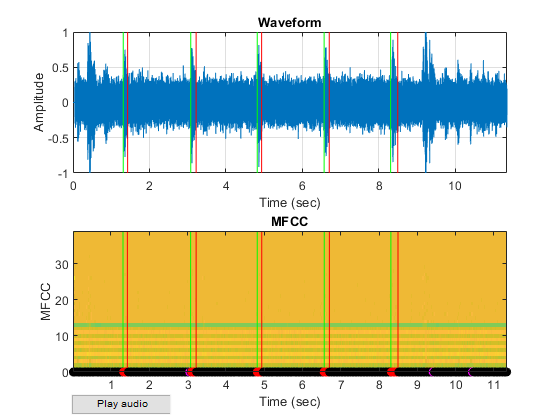
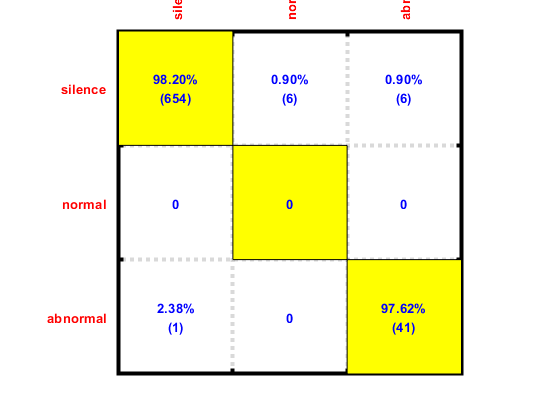
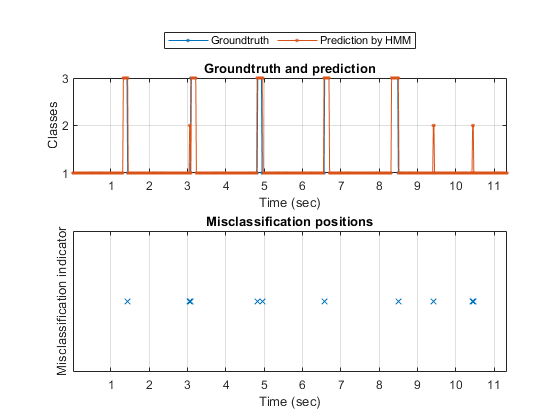
Time=3.87035 sec, accuracy=98.1638%
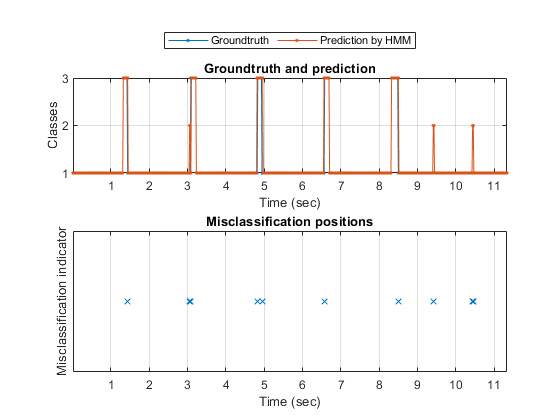
2/2: file=D:\users\jang\app\anomalySoundDetect-iii\anomalySoundDetect\dataset/normal-cue.wav
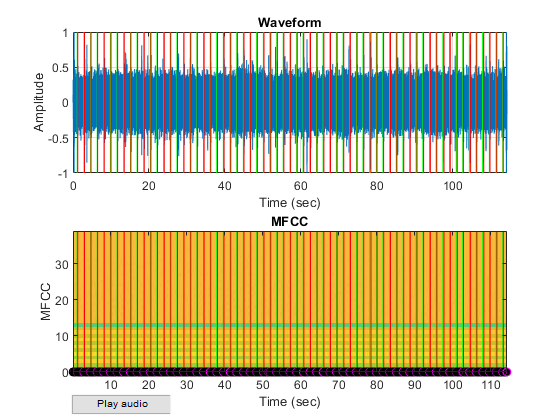
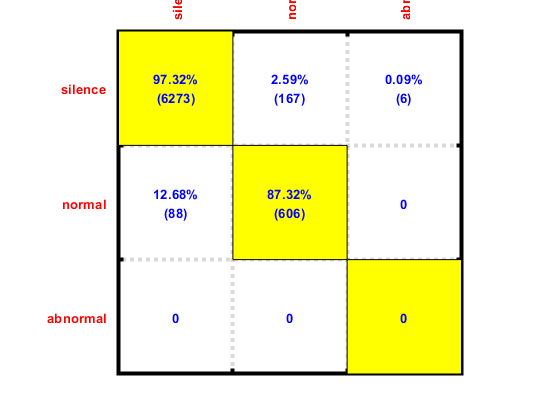
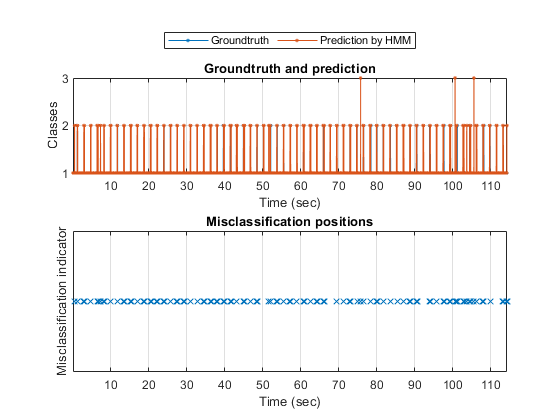
Time=25.2628 sec, accuracy=96.3445%
Summary
This is a brief tutorial on using HMM for ASD. As shown in the above examples, HMM can achieve a decent result on the training dataset. In particular, most of the errors occurs at boundaries with possibly ambiguous human labeling. As a result, the accuracy should be even higher. However, since we do not have extra data for test, the capability of HMM cannot be evaluated objectively.
There are several directions for further improvement:
- Acquire more audio files for objective evaluation of all classifiers.
- Investigate new features for ASD.
- Change the configuration of the GMM used in HMM.
- Use other classifiers for ASD.
Appendix
List of functions, scripts, and datasets used in this script:
Date and time when finishing this script:
fprintf('Date & time: %s\n', char(datetime));
Date & time: 20-Jan-2020 00:27:18
Overall elapsed time:
toc(scriptStartTime)
Elapsed time is 116.175418 seconds.
Jyh-Shing Roger Jang, created on
datetime
ans = datetime 20-Jan-2020 00:27:18
If you are interested in the original MATLAB code for this page, you can type "grabcode(URL)" under MATLAB, where URL is the web address of this page.